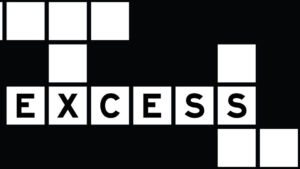By Middlemarch, if that’s a time and not a place, the brokers at Macquarie Bank were starting to turn on their four larger brethren.
The higher-for-shorter surge in the Big Four share prices which almost singlehandedly led the ASX200 to clock its most recent record all-time high, triggered something dark and fearful which appears to have been brewing in local brokers for some time.
Certainly the bump in valuations was enough for Macquarie to pull all the plugs.
The broker doubled down on its bearish bearing, slapping the Big Four lenders with some direct advice, telling clients to ‘underweight everything.’
At the time, Macquarie hit the panic button, unable to reconcile the rising share prices with the banking majors’ fundamentals which just didn’t sit right for the thinkers at the fifth major.
Westpac copped it worst, hit with the rarest of rare double downgrades. Going from Outperfrom to Underperform with the clack of a keyboard.
Yet, according to the latest fussing and fiddling by the professional services firm KPMG – itself one of the Big Four accounting majors – the Big 4 Aussie major banks just reported a combined 1H profit after tax of $15 billion.
Steve Jackson, head of banking & capital markets, KPMG Australia says that post-tax half-year numbers are down about 10.5% compared to the first half of last year, and an average of 0.3% (from $15.1 billion) for the second half of FY23.
It’s a tricky read, to be honest, when compared to the souring of sentiment the majors have been attracting from the country’s brokers.
Two weeks ago, Citi straight up recommended investors pull the plug and sell out of all Big Four lenders.
Citi downgraded Westpac and ANZ, bringing those into line with the “sell” ratings the broker already slapped on Commonwealth Bank and National Australia Bank shares.
Citi called CBA just “too expensive” while competition and slowing credit growth were putting the squeeze on NAB’s dominant business banking arm.
Yet this is how the banks have gone so far in 2024, despite the almost universal agrrement on their gloomy outlook.
Via Morningstar
Not too shabby for high dividend paying stalwarts.
Battered but still biggest
KPMG is less of that opinion.
Maria Trinci, banking partner, reckons the latest results demonstrate the continued strength of the majors.
“Maintaining asset base growth, healthy capital and liquidity positions and with credit quality continuing to show no significant signs of stress.”
As we’ve been hearing for donkey’s, the biggies belted out an extraordinary 1H23 – rich with records and buybacks.
That’s around the time analysts started to put the mockers on. Sensing the cycle was swinging deeper and fuller, pretty much everyone started to back off the Big 4 and the advice seemed spot on, as 2H23 dropped with a splat and little to love on the outlook.
With a record first half profit performance and a softer second half, KPMG says FY23 was very much a year of two halves.
One of my fav financial lingo fallbacks.
“The Majors’ performance has stabilised in 1H24 in line with the 2H23 position,” Trinci said.
“Profits have come off from the highs of 1H23, but income is broadly flat, the pace of margin erosion has slowed and operating expenses have reduced modestly compared to 2H23.”
Margin erosion aside, even to the ASX galaxy of small caps, the Big Four dominate Australia’s financial universe, ensuring we’re all somewhere in orbit around the gravitational pull of at one, if not all of them.
In a country not known for big numbers, their combined total assets stand somewhere near $3.85 trillion.
On a good, happy, happy-with-China-shaped year, that’s still twice the size of our annual economic output.
Most of us directly own shares in these banks, the rest of us do but do’t really know it via our superannuation funds, which would be hard pressed to explain why they’re not all up in the face of these preeminent Aussie instsitutions.
And the country’s no mug on this front either – Australia holds the fourth‑largest pool of investment fund assets in the world and certainly the largest in Asia.
Last month Nathan Zaia Morningstar’s senior equity analyst tried to put his finger on the big bank malaise striking fear into fundies.
After reasonably uneventful earnings updates, it is hard to pinpoint a single specific driver for the turnaround in bank sentiment, Nathan said.
“Still, we think part of it is that a likely lower cash rate eases housing fears and provides banks an opportunity to reprice loans and deposits to protect margins. Major bank share prices increased 23% since November 2023, outperforming the 16% increase in the Morningstar Australia Index over the same period.
According to Morningstar, the major banks’ weighted average price/fair value estimate is 1.14, up from 1.05 in the last quarter. Non-major banks trade at a price/fair value of 0.85.
“Australian banks face low credit growth, softer net interest margins, and an increase in loan losses in the short term.”
Zaia says banking secor returns on equity will be suppressed in fiscal 2024.
“Hence, we expect the banks to change loan and deposit pricing in the medium term to lift margins to a level that allows the wide-moat-rated major banks to generate returns above their cost of equity.
“Net interest margins are softening due to competition in loan and customer deposit rates.
“Repayment of cheap Reserve Bank of Australia funding and above-average refinancing activity are elevating competition.
“When banks had a large loan book on higher rates, cheaper loans to new customers could be made while the bank still achieved strong returns overall. However, excess returns are now modest, making it unlikely this trend will continue.
“We expect banks will pull back from aggressive competition on new loans and deposit rates.”
Some bullies on the Big 4’s 1H24:
Every six months KPMG, which has a cracking financial services analyst team, run the ruler over the four of them as a unit dropping a Major Australian Banks: half year 2024 results analysis.. And I find the outcome always interesting.
Total operating income in 1H24 is broadly flat on the 2H23 result, decreasing by 0.02 per cent to $44.5 billion. This follows a record 1H23 income performance of $45.7 billion.
Despite an increase in interest-earning assets of 1.9 per cent, total net interest income decreased by 0.5 per cent compared with 2H23 to $36.8 billion.
This was due to further margin erosion, although at a slower pace than 2H23, driven by continued strong competition within the mortgage market and increased costs of deposit funding.
Average Net Interest Margin (NIM) was 179 basis points during 1H24, a decrease of 11 basis points from 1H23 and 5 basis points from 2H23.
The average Liquidity Coverage Ratio (LCR) increased to 135.3%, up 100 basis points from 2H23.
The average CET1 ratio across the four banks has increased by 10 basis points to 12.6% from 2H23.
The Majors declared higher interim dividend payments in 1H24 with an increase in the average interim dividend per share of 2.9 per cent compared to 1H23.
The Majors booked $1.21 billion in impairment charges in 1H24, approximately 13 per cent lower than over the past 12 months. Over the first half, the average provisions as a percentage of gross loans and advances remained steady at 0.68%.
Total impaired loans have increased by 2.2 per cent across the Majors in the last 12 months, although this is in the context of continued overall portfolio growth.
Capital and liquidity ratios across the Majors remain well above regulatory minimums, demonstrating balance sheet and liquidity strength.
The average Liquidity Coverage Ratio (LCR) increased to 135.3%, up 1 percentage point from 2H23 and the average CET1 ratio is 12.6%, an increase of 10 basis points compared with 2H23.
Frank Mirenzi, VP and senior credit officer at Moody’s Ratings, says the latest reporting cab off the rank, Australia and New Zealand Banking Group (ASX:ANZ), delivered first-half fiscal 2024 results that were, ahem, credit neutral. Not the highest of praise.
“Australia and New Zealand Banking Group’s first-half fiscal year 2024 results are credit neutral. The bank’s cash earnings of AUD3.6 billion fell by only 1% compared with that in the prior period, largely due to a 27% increase in Markets income, with net interest income declining by 1%.
ANZ’s net interest margin fell 2bps, excluding Markets, driven by the impact of home lending competition and higher wholesale funding and deposit costs.
Aside from a generous buyback, Jeff Cai at Jarden was a little more blunt regarding ANZ.
“Overall, a slightly disappointing result. While cash profit of $3.55bn was in line with expectations (JARDe: $3.54bn, VA consensus: $3.53bn), that was helped by materially lower BDDs.
“1H24 headline NIM was a big miss to expectations but impacted by the recognition of markets income. Excluding this impact, it fell 2bps to 1.63%, a touch better than expected (JARDe: 1.61% and consensus: 1.62%). While revenue was in line, costs were ~2% ahead of expectations.
“The key positive for us out of the result was capital with CET1 of ~13.5% above expectations, which saw ANZ announce a $2bn buyback, potentially larger ⁄ earlier than some investors had expected.”
“We expect these earnings challenges to persist into the second half.
“Balance sheet settings remain strong with low levels of problem loans, high loss provisions and very strong capitalization. The group announced a AUD2 billion share buyback and on a proforma basis. Coupled with the impact of the Suncorp-Metway acquisition, the bank’s Common Equity Tier 1 ratio would remain high at 11.85%.”
Cai was more upbeat over Westpac which also dropped quarterlies this week, maintaining Jarden’s Overweight Rating and calling the first half for WBC a “solid operational result but questions remain on the medium-term outlook.”
The highlight here – the hero of the Big 4 1H dish – is almost certainly WBC’s succesful investment in improving service levels, which Jeff says is bearing fruit, with a significant improvement in mortgage turnaround times.
“This appears to have allowed it to increase its pricing relative to peers while maintaining solid mortgage growth in line with systems.”
Jeff says WBC’s 1H24 results were solid and better-than-expected across most measures. The stabilisation in core NIM at 1.80% was a highlight, with guidance suggesting it should remain ‘flattish’ ahead.
“That said, the better-than-expected results were arguably overshadowed by unanswered questions on the outlook, namely the outlook for costs in FY25E, as WBC’s tech simplification project (UNITE) gets underway. Along with the topic of CEO succession, this creates material uncertainty for the medium-term outlook.
“That (also) said, these were still solid results and the improvements in the underlying business suggest a turnaround is underway.
“We upgrade our FY24 and FY25 EPS forecasts by ~1% and ~2%, respectively. We maintain our Overweight rating, with WBC remaining our second pick in the sector and preferred ‘value’ bank.”
Margin call
The Majors all cited strong competition as a key driver of margin pressure, including other ADIs acquiring market share and non-traditional lenders entering the market.
Kim Lawry, KPMG Australia banking partner, says the combined household lending market share of the Majors decreased by 0.4% over the last 12 months, consistent with the decrease of 4.1%since mid-2019.
“Despite continued strong competition in the mortgage market and higher fundings costs, athe compression of net interest margins for the Majors has moderated in the first half of the financial year.”
She says operating expenses, which were rising in FY23, have turned a corner and reduced modestly in 1H24 by 1.0 per cent compared to 2H23.
“The average cost to income ratio in 1H24 is 48.7% which is a reduction of 40 basis points on 2H23, although still 348 basis points above 1H23 levels. Personnel remains the largest contributor to operating expenses, and over the past 12 months the Majors have reduced total headcount by approximately 0.5 per cent with personnel expenses down 0.3 per cent compared with 2H23.”
The post They’re all supposed to be a sell. So how come the Big 4 just reported a combined $15bn post-tax profit? appeared first on Stockhead.






















